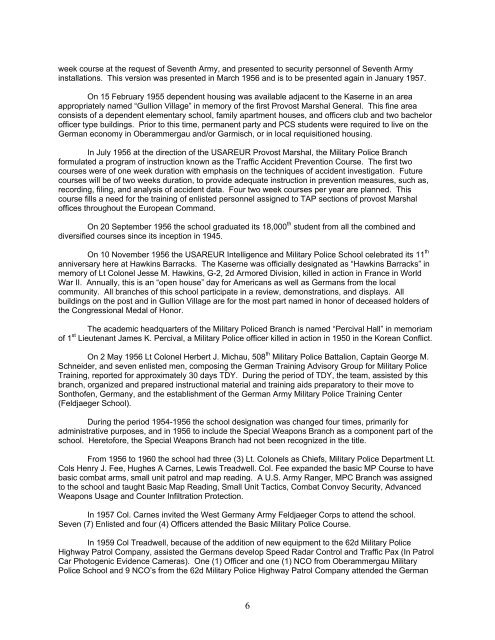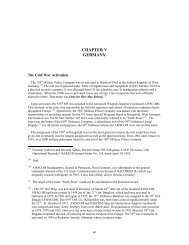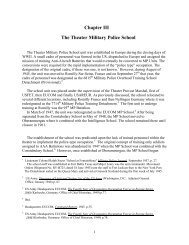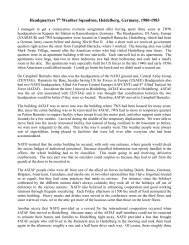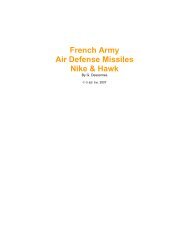The Theater Military Police School - USAREUR Main Page
The Theater Military Police School - USAREUR Main Page
The Theater Military Police School - USAREUR Main Page
You also want an ePaper? Increase the reach of your titles
YUMPU automatically turns print PDFs into web optimized ePapers that Google loves.
week course at the request of Seventh Army, and presented to security personnel of Seventh Army<br />
installations. This version was presented in March 1956 and is to be presented again in January 1957.<br />
On 15 February 1955 dependent housing was available adjacent to the Kaserne in an area<br />
appropriately named “Gullion Village” in memory of the first Provost Marshal General. This fine area<br />
consists of a dependent elementary school, family apartment houses, and officers club and two bachelor<br />
officer type buildings. Prior to this time, permanent party and PCS students were required to live on the<br />
German economy in Oberammergau and/or Garmisch, or in local requisitioned housing.<br />
In July 1956 at the direction of the <strong>USAREUR</strong> Provost Marshal, the <strong>Military</strong> <strong>Police</strong> Branch<br />
formulated a program of instruction known as the Traffic Accident Prevention Course. <strong>The</strong> first two<br />
courses were of one week duration with emphasis on the techniques of accident investigation. Future<br />
courses will be of two weeks duration, to provide adequate instruction in prevention measures, such as,<br />
recording, filing, and analysis of accident data. Four two week courses per year are planned. This<br />
course fills a need for the training of enlisted personnel assigned to TAP sections of provost Marshal<br />
offices throughout the European Command.<br />
On 20 September 1956 the school graduated its 18,000 th student from all the combined and<br />
diversified courses since its inception in 1945.<br />
On 10 November 1956 the <strong>USAREUR</strong> Intelligence and <strong>Military</strong> <strong>Police</strong> <strong>School</strong> celebrated its 11 th<br />
anniversary here at Hawkins Barracks. <strong>The</strong> Kaserne was officially designated as “Hawkins Barracks” in<br />
memory of Lt Colonel Jesse M. Hawkins, G-2, 2d Armored Division, killed in action in France in World<br />
War II. Annually, this is an “open house” day for Americans as well as Germans from the local<br />
community. All branches of this school participate in a review, demonstrations, and displays. All<br />
buildings on the post and in Gullion Village are for the most part named in honor of deceased holders of<br />
the Congressional Medal of Honor.<br />
<strong>The</strong> academic headquarters of the <strong>Military</strong> <strong>Police</strong>d Branch is named “Percival Hall” in memoriam<br />
of 1 st Lieutenant James K. Percival, a <strong>Military</strong> <strong>Police</strong> officer killed in action in 1950 in the Korean Conflict.<br />
On 2 May 1956 Lt Colonel Herbert J. Michau, 508 th <strong>Military</strong> <strong>Police</strong> Battalion, Captain George M.<br />
Schneider, and seven enlisted men, composing the German Training Advisory Group for <strong>Military</strong> <strong>Police</strong><br />
Training, reported for approximately 30 days TDY. During the period of TDY, the team, assisted by this<br />
branch, organized and prepared instructional material and training aids preparatory to their move to<br />
Sonthofen, Germany, and the establishment of the German Army <strong>Military</strong> <strong>Police</strong> Training Center<br />
(Feldjaeger <strong>School</strong>).<br />
During the period 1954-1956 the school designation was changed four times, primarily for<br />
administrative purposes, and in 1956 to include the Special Weapons Branch as a component part of the<br />
school. Heretofore, the Special Weapons Branch had not been recognized in the title.<br />
From 1956 to 1960 the school had three (3) Lt. Colonels as Chiefs, <strong>Military</strong> <strong>Police</strong> Department Lt.<br />
Cols Henry J. Fee, Hughes A Carnes, Lewis Treadwell. Col. Fee expanded the basic MP Course to have<br />
basic combat arms, small unit patrol and map reading. A U.S. Army Ranger, MPC Branch was assigned<br />
to the school and taught Basic Map Reading, Small Unit Tactics, Combat Convoy Security, Advanced<br />
Weapons Usage and Counter Infiltration Protection.<br />
In 1957 Col. Carnes invited the West Germany Army Feldjaeger Corps to attend the school.<br />
Seven (7) Enlisted and four (4) Officers attended the Basic <strong>Military</strong> <strong>Police</strong> Course.<br />
In 1959 Col Treadwell, because of the addition of new equipment to the 62d <strong>Military</strong> <strong>Police</strong><br />
Highway Patrol Company, assisted the Germans develop Speed Radar Control and Traffic Pax (In Patrol<br />
Car Photogenic Evidence Cameras). One (1) Officer and one (1) NCO from Oberammergau <strong>Military</strong><br />
<strong>Police</strong> <strong>School</strong> and 9 NCO’s from the 62d <strong>Military</strong> <strong>Police</strong> Highway Patrol Company attended the German<br />
6


